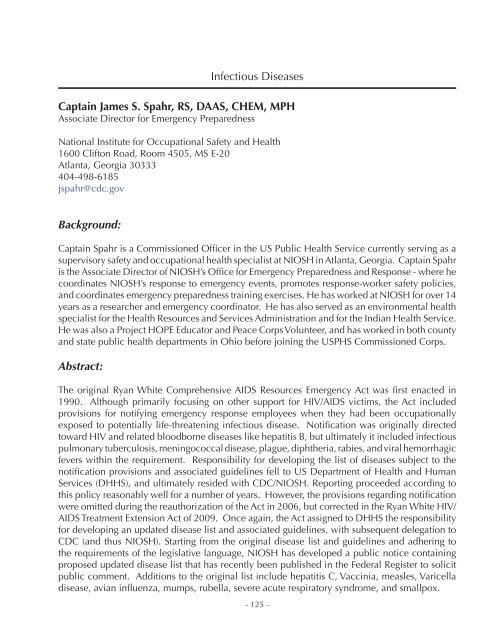Redmond EMS Abstracts.indd - IAFF
Redmond EMS Abstracts.indd - IAFF
Redmond EMS Abstracts.indd - IAFF
You also want an ePaper? Increase the reach of your titles
YUMPU automatically turns print PDFs into web optimized ePapers that Google loves.
Infectious Diseases<br />
Captain James S. Spahr, RS, DAAS, CHEM, MPH<br />
Associate Director for Emergency Preparedness<br />
National Institute for Occupational Safety and Health<br />
1600 Clifton Road, Room 4505, MS E-20<br />
Atlanta, Georgia 30333<br />
404-498-6185<br />
jspahr@cdc.gov<br />
Background:<br />
Captain Spahr is a Commissioned Officer in the US Public Health Service currently serving as a<br />
supervisory safety and occupational health specialist at NIOSH in Atlanta, Georgia. Captain Spahr<br />
is the Associate Director of NIOSH’s Office for Emergency Preparedness and Response - where he<br />
coordinates NIOSH’s response to emergency events, promotes response-worker safety policies,<br />
and coordinates emergency preparedness training exercises. He has worked at NIOSH for over 14<br />
years as a researcher and emergency coordinator. He has also served as an environmental health<br />
specialist for the Health Resources and Services Administration and for the Indian Health Service.<br />
He was also a Project HOPE Educator and Peace Corps Volunteer, and has worked in both county<br />
and state public health departments in Ohio before joining the USPHS Commissioned Corps.<br />
Abstract:<br />
The original Ryan White Comprehensive AIDS Resources Emergency Act was first enacted in<br />
1990. Although primarily focusing on other support for HIV/AIDS victims, the Act included<br />
provisions for notifying emergency response employees when they had been occupationally<br />
exposed to potentially life-threatening infectious disease. Notification was originally directed<br />
toward HIV and related bloodborne diseases like hepatitis B, but ultimately it included infectious<br />
pulmonary tuberculosis, meningococcal disease, plague, diphtheria, rabies, and viral hemorrhagic<br />
fevers within the requirement. Responsibility for developing the list of diseases subject to the<br />
notification provisions and associated guidelines fell to US Department of Health and Human<br />
Services (DHHS), and ultimately resided with CDC/NIOSH. Reporting proceeded according to<br />
this policy reasonably well for a number of years. However, the provisions regarding notification<br />
were omitted during the reauthorization of the Act in 2006, but corrected in the Ryan White HIV/<br />
AIDS Treatment Extension Act of 2009. Once again, the Act assigned to DHHS the responsibility<br />
for developing an updated disease list and associated guidelines, with subsequent delegation to<br />
CDC (and thus NIOSH). Starting from the original disease list and guidelines and adhering to<br />
the requirements of the legislative language, NIOSH has developed a public notice containing<br />
proposed updated disease list that has recently been published in the Federal Register to solicit<br />
public comment. Additions to the original list include hepatitis C, Vaccinia, measles, Varicella<br />
disease, avian influenza, mumps, rubella, severe acute respiratory syndrome, and smallpox.<br />
- 125 -

















